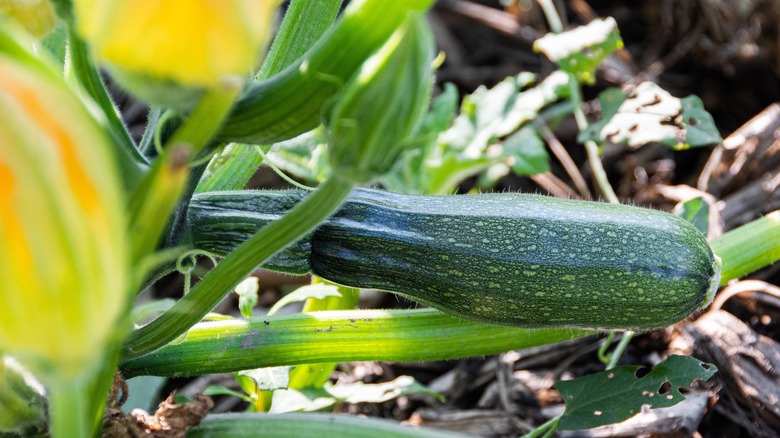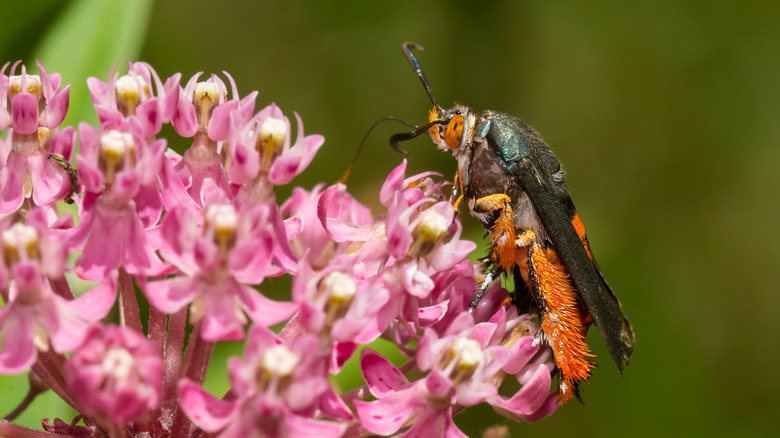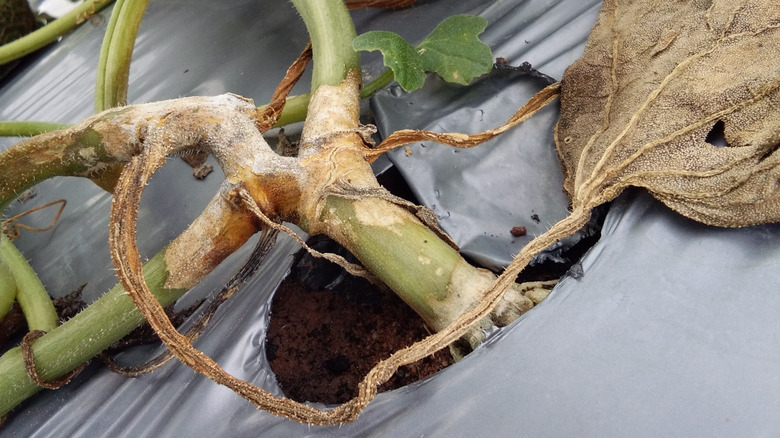How To Keep Zucchini Stems From Rotting
When it comes to zucchini stem rot, there are two main culprits: one is a small flying pest, known as the squash vine borer moth, and the other is a fungal infection specific to cucurbits, known as gummy stem blight. Luckily, the squash borer moth is only active during the mid-summer months, whereas Gummy stem blight mainly affects plants that have poor air circulation. This is one reason why overhead irrigation systems are considered a no-no when growing members of the cucurbit family. Bugs can be dealt with effectively by spraying your plants with organic pest control, while gummy stem blight can treated with fungicide.
A telltale sign of a vine borer moth infestation is small clusters of eggs on the stems and leaves of your plants. These tiny black and red moths are also active during the daytime. If you notice any wilting, discoloration, or oozing around the stems of your zucchini plants, then you're probably dealing with gummy stem blight. you should always remove all sick, dying, or dead plant debris as it's highly contagious and can be passed on for generations if not completely destroyed.
Vine squash borer moth
Even though they're only around half an inch long and incredibly fast flyers, the black and red coloring of these moths means they're not that difficult to spot. Unfortunately, if you're seeing the stems on your zucchini plants rotting away seemingly overnight, the damage has already been done. The eggs laid by the moth have already hatched, and the larvae have chewed their way into the stem of your beloved squash plants.
While you can do a daily visual inspection and remove any eggs that you might find, this isn't always the most time-efficient way to prevent these moths from depositing their destructive offspring. One of the easiest ways to control and prevent them is by using natural methods, like adding nematodes or diatomaceous earth mixed into the soil. Neem oil can be sprayed directly onto the infected part of the plants and also kills eggs and larvae. Squash borer moths cocoon themselves underground during the cooler winter months, so tilling your soil after the last zucchini harvest can dislodge any hidden cocoons, which then become bird food. Another option is to grow companion plants alongside your tasty 'zukes, which might help ward off those flying foes.
Gummy stem blight
Also referred to as black rot and stem canker, this nasty fungal infection is also known to create severe rotting in the stems of your zucchini plants. Gummy stem blight is caused by the bacteria didymella bryoniae, which infects the plant by entering through any flesh wound on the fruit or stem itself. Once the fungus takes hold and begins to spread, the stem begins to turn brown and secrete a sticky amber-colored fluid. Gummy stem blight eventually overtakes the rest of the plant, which leads to stunted growth, dark, rotten patches on any surviving fruit, and eventually, death.
If you suspect gummy stem blight, you'll want to apply a fungicide as soon as possible. Remove the infected plant and any dead or dying matter that it might slough off. Because the spores can go airborne, you'll want to keep a close eye on other plants, especially melons, cucumbers, and certain types of gourds.


